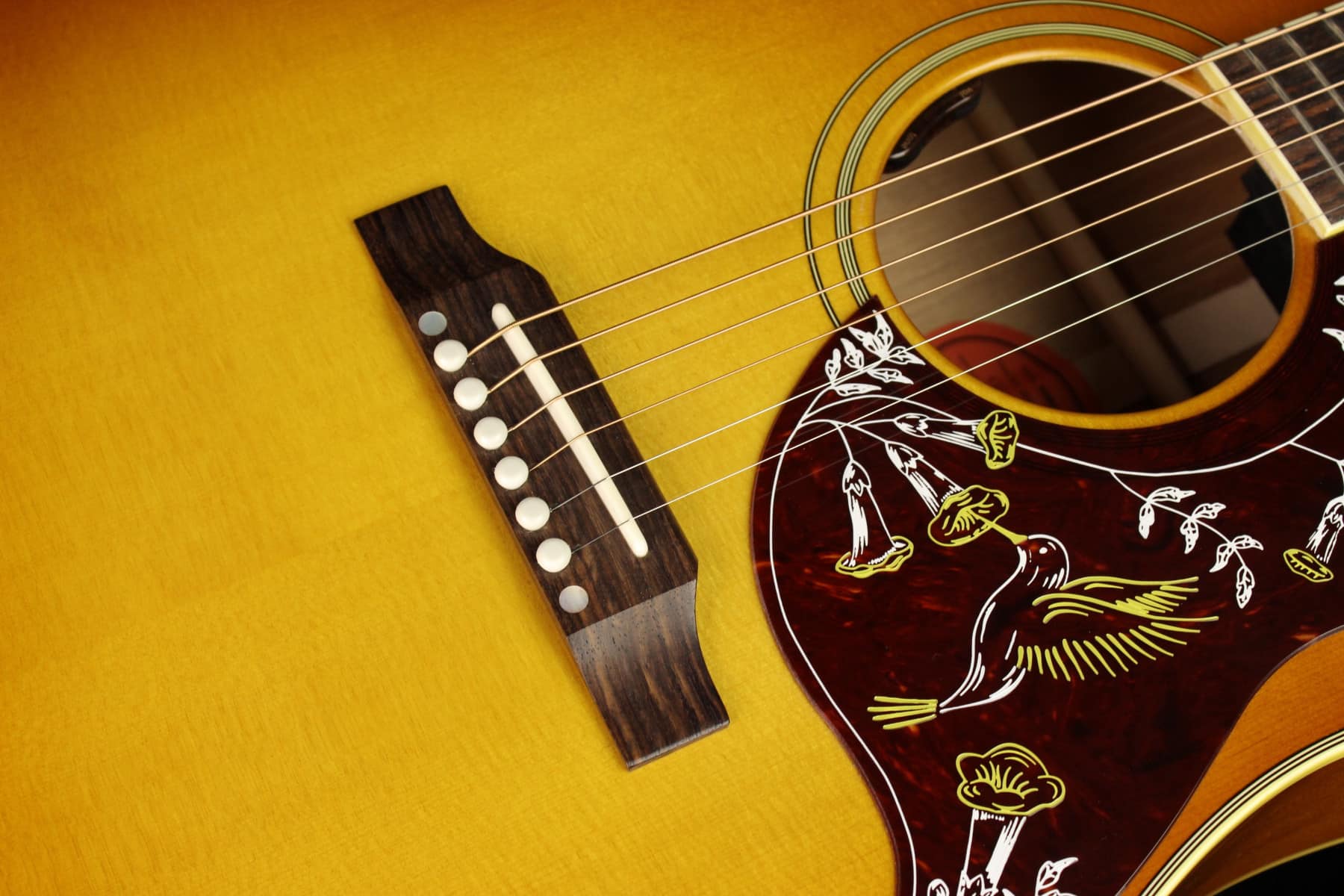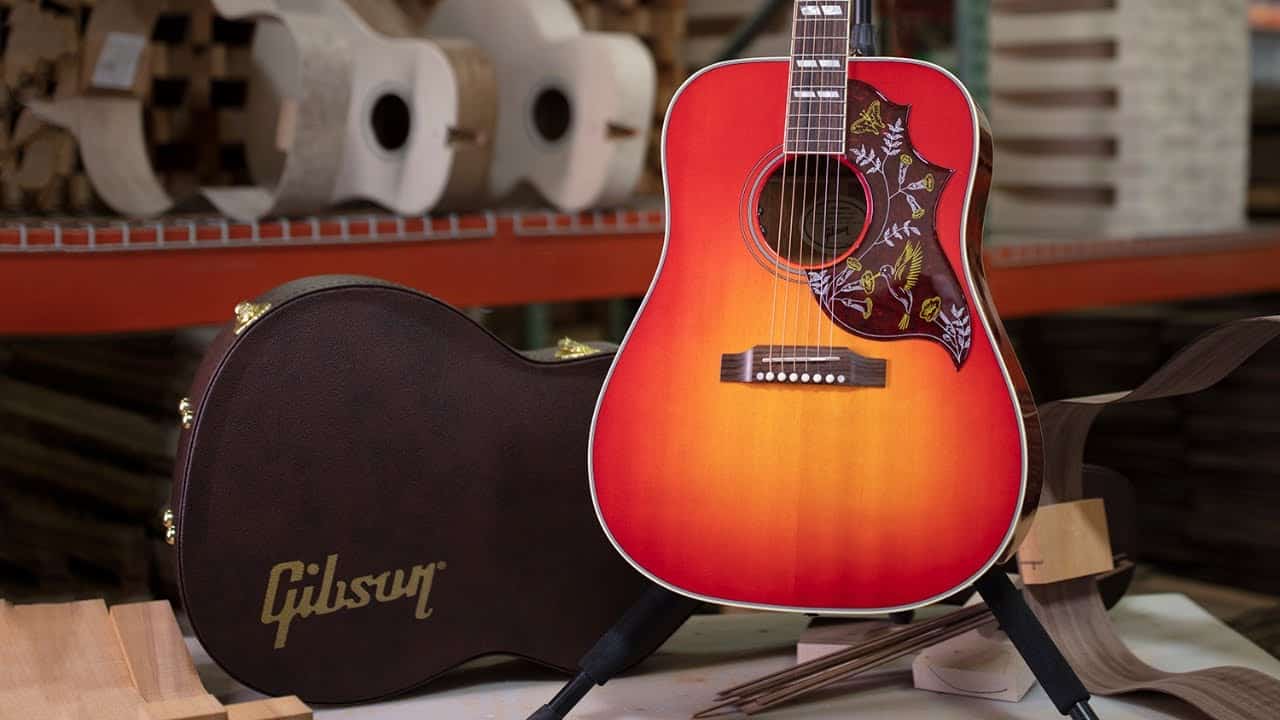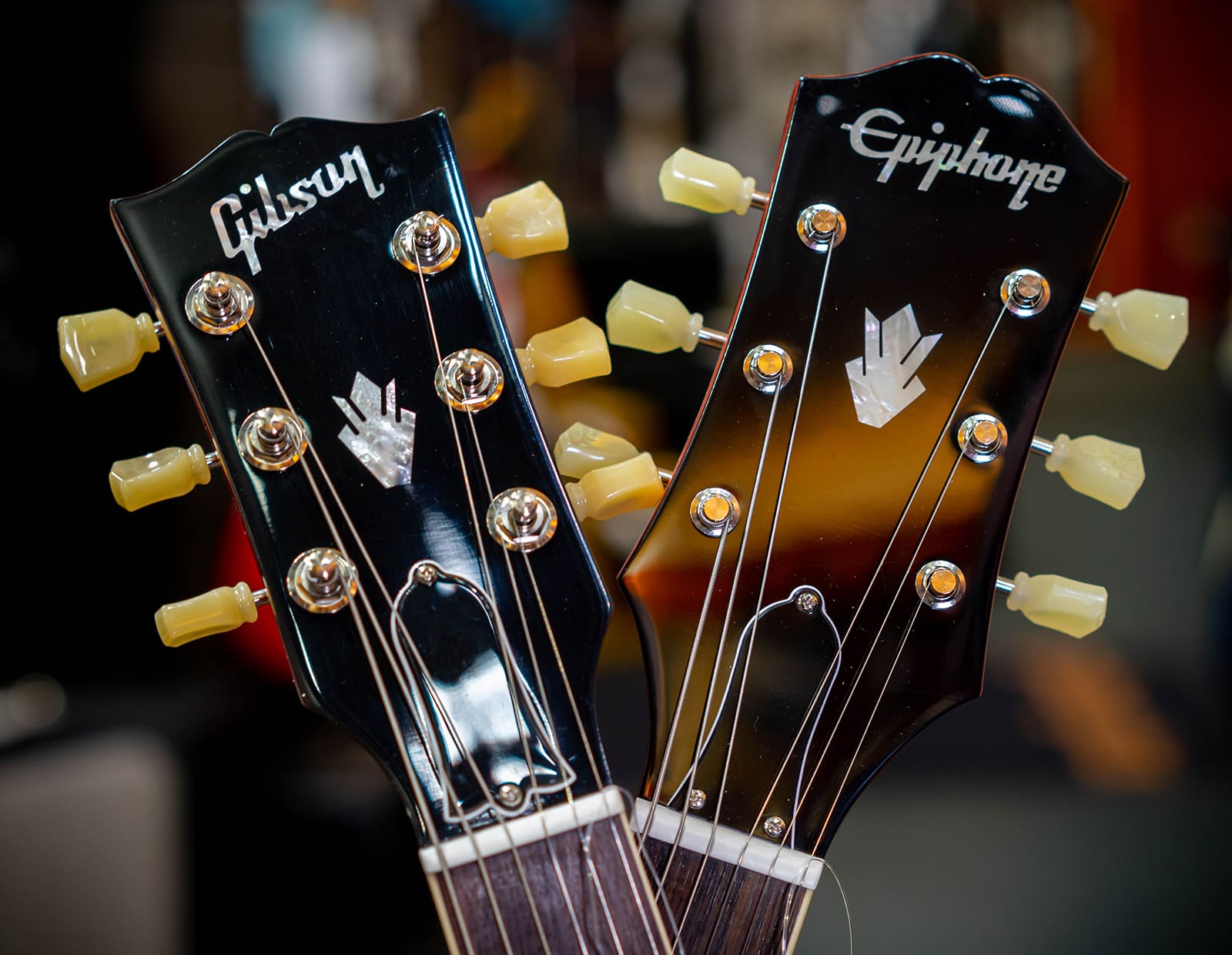Contents
One of the most remarkable acoustic guitars ever made is the Gibson Hummingbird. It is notable not only for its distinctly designed pickguard but because of its powerful sound output. Since not all players can afford it, this Epiphone Hummingbird vs Gibson Hummingbird comparison will introduce you to a more affordable alternative. Will the Epiphone be at par with Gibson? Is it wise to choose a more affordable Hummingbird that’s inspired by the original Hummingbird?
Original Gibson Hummingbird
The Gibson Hummingbird is oozing with greatness. It’s made of mahogany/spruce body featuring the traditional hand-scalloped X-bracing. The Gibson Hummingbird available today has both vintage and modern appointments and quality build.
Its pickguard, which features elaborate artwork of a hummingbird, has a dominant yellowish accent that complements the color finish of the guitar. You can get either Antique Natural or Heritage Cherry Sunburst finish.
Epiphone Inspired by Gibson Hummingbird
The Epiphone Hummingbird is very similar to the original Gibson Hummingbird, except that it’s available in different color finishes – Aged Cherry Sunburst gloss and Aged Antique Natural gloss. Instead of the traditional scalloped bracing, it features quarter sawn spruce bracing, which is technically machine scalloped bracing.

Still features a very identical artwork on its pickguard with the hummingbird. However, instead of a yellow accent, it comes with orange. This somewhat matches the aged look of the Epiphone Hummingbird.
Similarities and Differences of the Hummingbirds
One very obvious difference between these hummingbirds is the price. Gibson is definitely expensive, while the Epiphone is more affordable. This is a given. However, you will be surprised how well this Epiphone is in the following sections.
Specifications Comparison
Let’s start our review with a comparison of their specifications. There should be some similarities between these two because the Epiphone model is simply ‘inspired’ by Gibson. Take note of these differences and let’s check if there are significant variations between the two.
| Epiphone Hummingbird | Gibson Hummingbird | |
| Body Shape | Square Shouldered Dreadnought | Square Shouldered Dreadnought |
| Body Material | Solid mahogany back and side with solid Sitka Spruce top | Mahogany back and side with Sitka Spruce top |
| Bracing | Quarter Sawn Spruce | Traditional hand scalloped X-bracing |
| Neck Shape | Rounded C | Round |
| Neck Wood | Mahogany, Glued in, Tapered Dovetail Set Neck |
Mahogany, Compound Dovetail Neck-to-body |
| Scale Length | 24.72″ / 628mm | 24.75″ / 628.65mm |
| Fretboard Material | Indian Laurel, Antique Ivory binding | Rosewood |
| Fretboard Radius | 12.01″ | 12″ |
| Number of Frets | 20 medium jumbo frets | 20 standard frets |
| Nut Width | 1.69″ / 43mm | 1.72″ / 43.81mm |
| Pickups | Fishman Sonicore Under Saddle pickup | LR Baggs VTC Under Saddle pickup |
| Controls | Fishman Sonitone Soundhole Volume and Tone controls | Volume and Tone controls |
| Tuning Machines | Epiphone Deluxe with press in gold bushings | Gotoh Keystone |
Design & Build
We know that the Gibson Hummingbird is really an outstanding guitar, but the Epiphone Hummingbird has a very impressive build. Both feature square-shouldered body shape and scalloped bracing, which could influence the tonal capabilities of these guitars.
These hummingbirds both feature split parallelogram fretboard inlays. You can also find Hummingbird on the truss cover for both guitars. For the pickguard, they feature identical artwork, but the quality of the material is different. Gibson has a harder pickguard, while Epiphone has softer material.

Another notable difference between the two is the finish. The original Gibson has glossy Nitrocellulose finish, while the Epiphone Hummingbird has an aged gloss finish, more like semi-gloss polyurethane. The Epiphone finish seems to gracefully give the guitar aged look over time.
Playability
Gibson Hummingbird has a shorter scale length, but has a narrower width. On the other hand, the Epiphone has a more rounded modern feeling than the Gibson. Both guitars have bone nut and saddle that allow maximum transfer of sound energy to the neck and top through the saddle.
Some players find their Gibson to have a much higher action out of the box. Yet, the setup to adjust the action can be very easy. You must have it done by a professional luthier if you aren’t confident of doing it yourself.
Sound
You’ll definitely love the sound of these guitars, but there’s a slight difference in their sound character. Though they both have the sound of the mahogany square-body guitar, Gibson is different from the Epiphone. This can be attributed to the shape and the bracing.
The Gibson Hummingbird has more depth and complexity of sound, while Epiphone has better projection. Gibson has less bright, more rounded trebles and articulate mid-range, Epiphone has warmer tones. Therefore, if you are looking for an acoustic guitar for recording, you need Gibson’s mellower tone. Otherwise, if you need a guitar for live performance, the Epiphone Hummingbird is the best for you.
You might want to check this YouTube video from Alano Music first. This video details some useful information to help you in choosing the one for you. Towards the end of the comparison, you can hear the head-to-head sound review of these guitars.
Price
There’s really a huge difference in their price tags. Obviously, Gibson is more expensive, which costs several thousand dollars. The cheaper substitute, the Epiphone Hummingbird, only costs less than $1000. Are you willing to spend more for a Gibson, given that Epiphone is excellently made to sound more like the Gibson?
Conclusion
Gibson Hummingbird is among the most popular acoustic guitars on the market. Indeed, the quality, sound, and playability of this guitar are beyond your expectation. Yet, another Hummingbird took on the challenge, so we compare Epiphone Hummingbird vs Gibson Hummingbird.
You know a lot about Gibson. Not only do you get premium quality, but you’ll also get unparalleled sound quality. However, in this comparison, Epiphone was able to make it ‘almost’ sound like the original Gibson. So, now, the question would be, is the original Gibson worth the money, when you can get the cheaper Epiphone?

The sound difference might not be that huge, but given that you’re holding a piece of history, you are also partly paying for it. The pride that you own a Gibson is quite expensive. And, the price? The difference between the price of these two Hummingbirds. So, if you want to play great without spending too much, get the Epiphone Hummingbird.

Hi music fan! I am Jeff. Hope that you enjoy some stuff I shared here in my personal blog.
About myself, Currently I am in charging as Artist Manager/Music Supervisor at 72 Music Management. I did managed album to Grammy Award in 2017 with 7 Nominations from 2014-2020 and had the opportunities to work with : A.J. Croce, Blind Boys of Alabama, Bobby Rush, Dom Flemons, Dustbowl Revival, Sarah Grace
Governor of the Memphis Chapter of The Recording Academy is one of a award that I am lucky to achieved.
